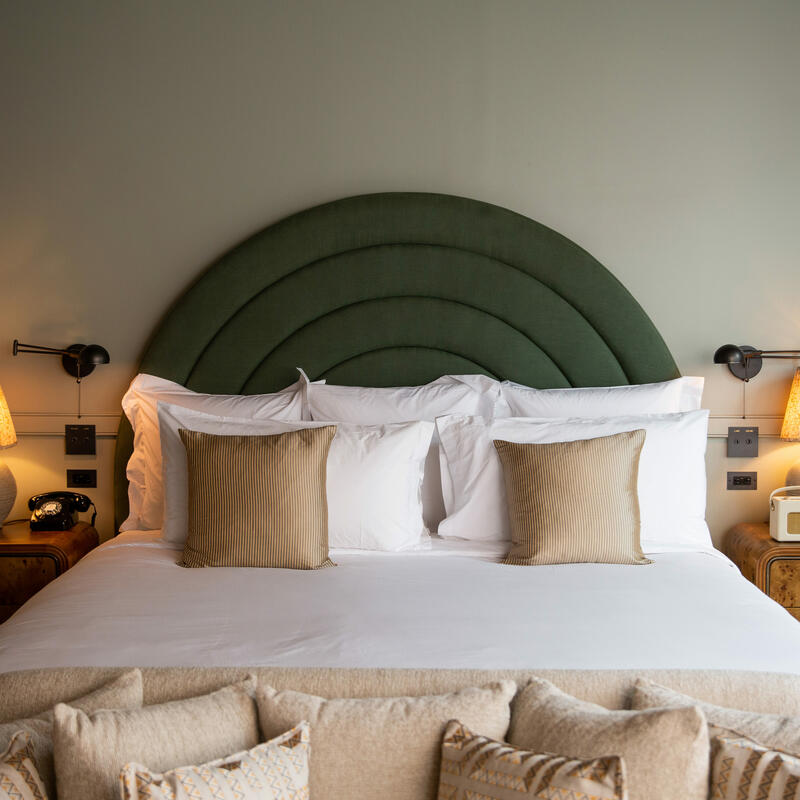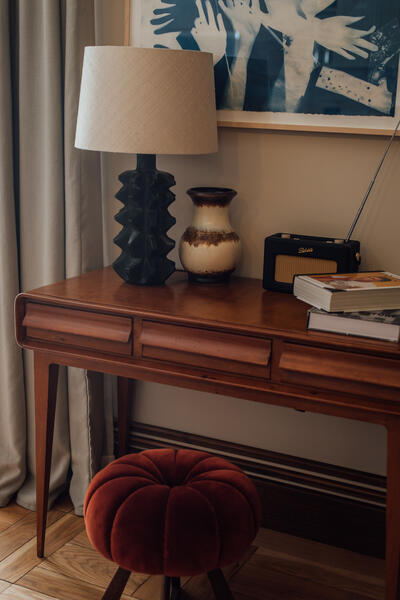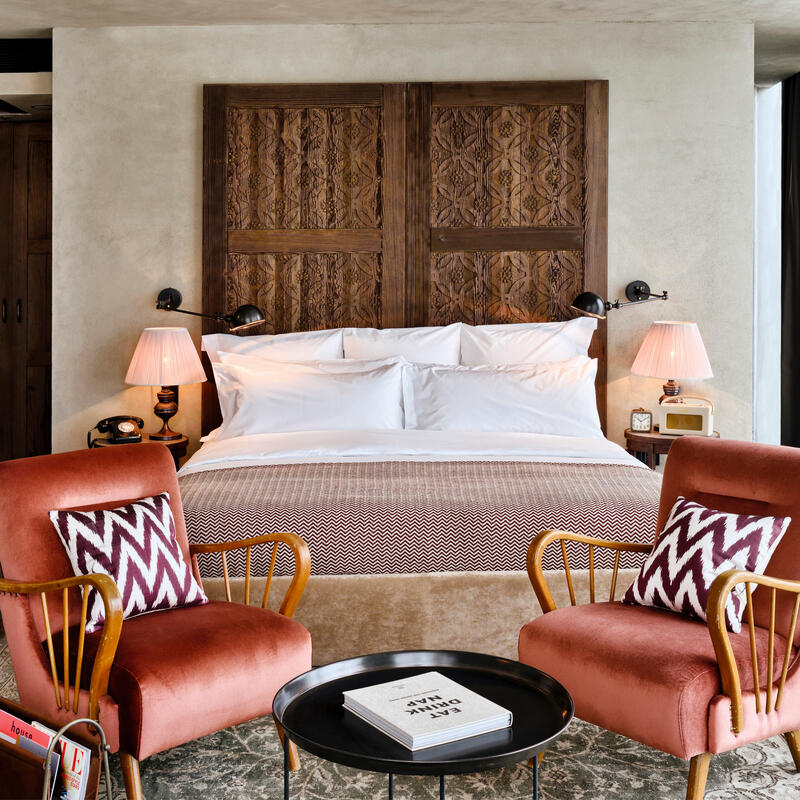By Megan Murray
We believe that a good night's sleep is one of life's great pleasures, and that a well-designed bedroom will help you along the way. When designing them for our Houses, we ensure that comfort is the focus, because as well as looking good they should be easy and functional to use.
For our design team, this means creating a floor plan that flows, giving our guests storage options to keep their belongings neat and tidy, and ensuring that there's always a dedicated area to get ready for a night out. From the simple clothing pegs on a panelled wall at Soho Farmhouse to the under-bed storage in the smallest rooms at Soho House Paris, each bedroom balances practicality with layers of texture, pattern and colour to create an effect that feels both homely and a treat.
The Soho Home Design service pulls together more than just aesthetics, too. Considering the unique character of the building - and crucially - the needs of the individual, it all contributes to a well thought out space.
Here, Soho Home Interior Style Manager, Candy Murray, shares how she plans bedroom renovations and redecoration with her clients, drawing inspiration from the Houses and ensuring that the space feels personal.
From hardware to fabric swatches, let these simple steps guide you.


Start with function
'The first thing I always do with Soho Home Design clients is understand how they use their bedroom,' says Murray. 'We talk through when they spend time in this room, who in the household uses it, and what would be a dream feature.
'When envisioning your bedroom, some initial questions could be: do you have kids, and will they be running in and out, and jumping on the bed? If so, don't overly dress the bed or include too many ornaments that are easy to break. Is fashion and getting ready important to you? If so, we would prioritise an area to hang clothes, with a long mirror and maybe even a walk-in wardrobe, if there's space.
'Are you a big reader? And would you rather read in bed or in a chair? If you love nothing more than relaxing in bed with the paper on a Saturday morning or you always read a chapter before going to sleep, then a large, upholstered, comfortable headboard is essential to prop yourself up on.
'One of our clients loves watching films in bed and so we installed a huge projector that retracted from the ceiling. Your bedroom should reflect you, and your wants and needs.'


Consider the room
'Now that you know what (in an ideal world) you'd like from your bedroom, it's time to make it a reality in a way that optimises the space you have. Look around and consider any architectural features to emphasise - the size of the windows, height of the ceiling, etc.
'Easy rules to follow are to make a feature of any windows and maximise natural light. Try not to put large pieces of furniture in front of them. Think about if there's space to have a mirror in a position that benefits from that light, and you might want to angle seating towards the window, too.
'In terms of architecture, consider features that you could focus on. In my home, for example, my bedroom has a classic fireplace with alcoves either side, so I've used this space to create wardrobe storage.'


Make a floor plan
'Think about the flow of the room - avoid cutting off doorways, windows or covering up original features. Then, when plotting in furniture, start with the bed as this is the biggest and most important piece.
'If you can, position it in the centre of a main wall, and plan in a bedside table and lighting options either side. This creates a sense of symmetry and, as always, comfort and practicality should be the main concern.
'Next, look at storage. Do you have a lot of storage space or will this be a struggle? In the bedrooms at Soho House Paris, we used wall hooks for hanging jackets and under-bed drawers to save on floor space for foldable garments. Make a map of the room and circle areas that could take a dresser or wardrobe.
'If you do have room for seating, try and incorporate it into your floor plan if you can. Most House bedrooms have a pair of occasional chairs positioned at the end of the bed, and this is a way to balance style and practicality. It changes the dynamics of the room and helps you to relax. It's much nicer to have a seat, small sofa or bench to sit and put your shoes on than balancing on the edge of the bed.'



Plan in lighting and hardware
'If you're renovating, this is the time to think about plug sockets, lighting wiring, and switches. I'd recommend planning a table lamp either side of the bed and potentially a wall reading light, too. Floor lamps work well in the corner of the room, perhaps behind an occasional chair.
'Two wall sconces at equal height on either side of the bedroom offer a warm glow. And as for overhead, a small to medium-sized pendant feels soft and stylish. Opt for a mottled, flecked or textured glass for a hazy light.
'There's nothing worse than a million different light switches - all you need are two different dimmers: one for ceiling and wall lights, and one for any table and floor lamps. Have only two sets of switches as well: one by the door and one by the bed; both should control every light in the room.
'When thinking about sockets, you might want to factor in a space for getting ready, such as a vanity table, with plugs for hairstyling tools and a table lamp. Our rule of thumb is to have sockets for your electronics at the same height as the desk or table they'll rest on.'



Choosing a colour palette
'It's typical to go for a calming colour palette in a bedroom and, again, it all comes down to how you want to use the room. For some people, this space needs to be relaxing and so a base of natural-inspired neutrals works really well, or a spectrum of pale and earthy greens.
'Personally, I think that bedrooms are a fun place to experiment with colours and design in general, so I actually like the idea of using quite bold or even dark, moody colours.
'An easy way to start, though, is to opt for natural colours and materials for the walls, floor and main pieces of furniture, and then use your accessories to pull out different hues. For example, in a Medium bedroom at Soho House Istanbul, a pair of rust armchairs with patterned, aubergine cushions and a mauve bedspread bring warmth to the cream walls and wooden flooring by accentuating a rich colour palette through fabrics. Or, at 76 Dean Street in London, cobalt blue seating and pale marigold curtains add contrast to an otherwise classic scheme.'


Bring together a mood board
'Before you start buying, though, pull together all of your finishes into a mood board - including paint colours, fabric swatches for the headboard, curtains and cushions, flooring, and a rug. Lay it all out to see how it works together before investing.
'It's important not to fall into cliches, too. Sometimes people think of the bedroom as a more typically feminine space, but I think it's an opportunity to be brave and have fun.
'A painted ceiling can be an interesting way to go. Or, try using artwork in a way that feels personal to you - maybe try a wall mural. When you're happy with the mood of the room all together, you can start the fun part and order the foundational items. After that, vintage pieces and decor you pick up on your travels or from independent stores is the way to layer up the room.'













